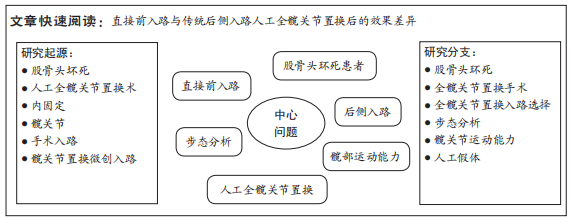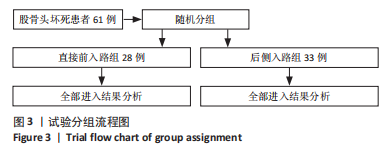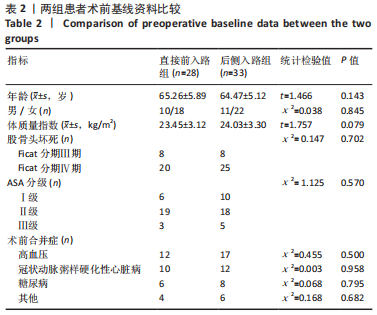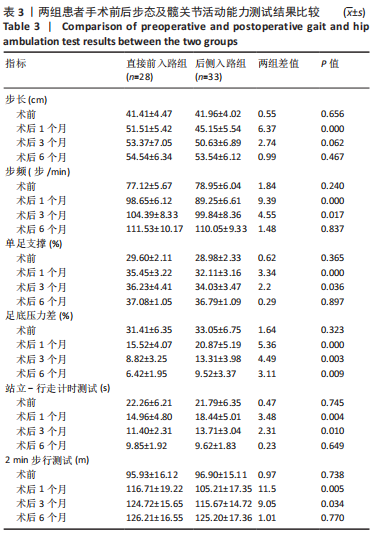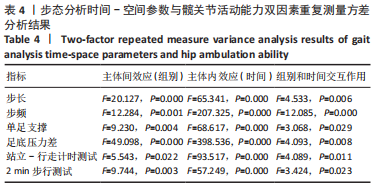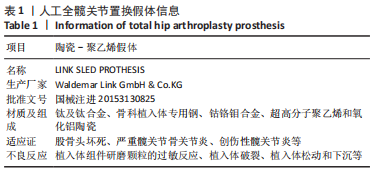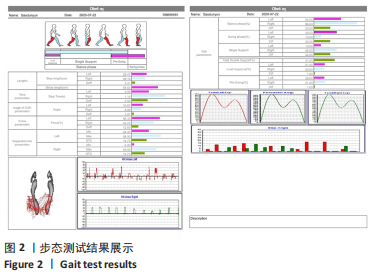[1] MCCRORY JL, WHITE SC, LIFESO RM. Vertical ground reaction forces: objective measures of gait following hip arthroplasty. Gait Posture. 2001;14(2):104-109.
[2] MANTOVANI G, LAMONTAGNE M, VARIN D, et al. Comparison of total hip arthroplasty surgical approaches by principal component analysis. J Biomech. 2012;45(12):2109-2115.
[3] LALEVÉE M, MARTINEZ L, REY B, et al. Gait analysis after total hip arthroplasty by direct minimally invasive anterolateral approach: A controlled study. Orthop Traumatol Surg Res. 2022;103521. doi: 10.1016/j.otsr.2022.103521.
[4] HOSKINS W, BINGHAM R, LORIMER M, et al. Early Rate of Revision of Total Hip Arthroplasty Related to Surgical Approach: An Analysis of 122,345 Primary Total Hip Arthroplasties. J Bone Joint Surg Am. 2020;102(21):1874-1882.
[5] YAN L, GE L, DONG S, et al. Evaluation of Comparative Efficacy and Safety of Surgical Approaches for Total Hip Arthroplasty: A Systematic Review and Network Meta-analysis. JAMA Netw Open. 2023;6(1):e2253942.
[6] PINCUS D, JENKINSON R, PATERSON M, et al. Association Between Surgical Approach and Major Surgical Complications in Patients Undergoing Total Hip Arthroplasty. JAMA. 2020;323(11):1070-1076.
[7] HUANG XT, LIU DG, JIA B, et al. Comparisons between Direct Anterior Approach and Lateral Approach for Primary Total Hip Arthroplasty in Postoperative Orthopaedic Complications: A Systematic Review and Meta-Analysis. Orthop Surg. 2021;13(6):1707-1720.
[8] STADELMANN VA, RÜDIGER HA, NAUER S, et al. Impact of capsular preservation on patient-reported outcomes and complication rates in total hip arthroplasty using the direct anterior approach. Bone Joint J. 2022;104-B(7):826-832.
[9] RIVERA F, COMBA LC, BARDELLI A. Direct anterior approach hip arthroplasty: How to reduce complications - A 10-years single center experience and literature review. World J Orthop. 2022;13(4):388-399.
[10] WANG Z, HOU JZ, WU CH, et al. A systematic review and meta-analysis of direct anterior approach versus posterior approach in total hip arthroplasty. J Orthop Surg Res. 2018;13(1):229-240.
[11] JIA F, GUO B, XU F, et al. A comparison of clinical, radiographic and surgical outcomes of total hip arthroplasty between direct anterior and posterior approaches: a systematic review and meta-analysis. Hip Int. 2019;29(6):584-596.
[12] MOERENHOUT K, DEROME P, LAFLAMME GY, et al. Direct anterior versus posterior approach for total hip arthroplasty: a multicentre, prospective, randomized clinical trial. Can J Surg. 2020;63(5):E412-E417.
[13] MAFFIULETTI NA, IMPELLIZZERI FM, WIDLER K, et al. Spatiotemporal parameters of gait after total hip replacement: anterior versus posterior approach. Orthop Clin North Am. 2009;40(3):407-415.
[14] BON G, KACEM EB, LEPRETRE PM, et al. Does the direct anterior approach allow earlier recovery of walking following total hip arthroplasty? A randomized prospective trial using accelerometry. Orthop Traumatol Surg Res. 2019;105(3): 445-452.
[15] LIN DY, SAMSON AJ, CEHIC MG, et al. Short-term difference only in reported outcomes (PROMs) after anterior or posterior approach to total hip arthroplasty: a 4-year prospective multi-centre observational study. J Orthop Surg Res. 2023; 18(1):119.
[16] PINCUS D, JENKINSON R, PATERSON M, et al. Association Between Surgical Approach and Major Surgical Complications in Patients Undergoing Total Hip Arthroplasty. JAMA. 2020;323(11):1070-1076.
[17] PENG L, ZENG Y, WU Y, et al. Clinical, functional and radiographic outcomes of primary total hip arthroplasty between direct anterior approach and posterior approach: a systematic review and meta-analysis. BMC Musculoskelet Disord. 2020;21:338.
[18] AWAD ME, FARLEY BJ, MOSTAFA G, et al. Direct anterior approach has short-term functional benefit and higher resource requirements compared with the posterior approach in primary total hip arthroplasty : a meta-analysis of functional outcomes and cost. Bone Joint J. 2021;103-B(6):1078-1087.
[19] JUNGWIRTH-WEINBERGER A, DO HT, KRELL EC, et al. Blood management in direct anterior versus posterior primary total hip arthroplasty using tranexamic acid: a matched cohort study. Arch Orthop Trauma Surg. 2023;143(1):91-95.
[20] CHA Y, YOO JI, KIM JT, et al. Disadvantage during Perioperative Period of Total Hip Arthroplasty Using the Direct Anterior Approach: a Network Meta-Analysis. J Korean Med Sci. 2020;35(18):e111.
[21] FAGOTTI L, FALOTICO GG, MARANHO DA, et al. Posterior versus anterior approach to total hip arthroplasty: a systematic review and meta‑analysis of randomized controlled trials. Acta Ortop Bras. 2021;29(6):297-303.
[22] NILSDOTTER A, BREMANDER A. Measures of hip function and symptoms: Harris Hip Score (HHS), Hip Disability and Osteoarthritis Outcome Score (HOOS), Oxford Hip Score (OHS), Lequesne Index of Severity for Osteoarthritis of the Hip (LISOH), and American Academy of Orthopedic Surgeons (AAOS) Hip and Knee Questionnaire. Arthritis Care Res (Hoboken). 2011;63( Suppl 11):S200-S207.
[23] NAMBIAR M, CHENG TE, ONGGO JR, et al. No Difference in Functional, Radiographic, and Survivorship Outcomes Between Direct Anterior or Posterior Approach THA: 5-Year Results of a Randomized Trial. Clin Orthop Relat Res. 2021; 479(12): 2621-2629.
[24] AWAD ME, FARLEY BJ, MOSTAFA G, et al. The risk of hospital readmission, revision, and intra- and postoperative complications between direct anterior versus posterior approaches in primary total hip arthroplasty: a stratified meta-analysis and a probability based cost projection. Hip Int. 2022;11207000211066454.doi: 10.1177/11207000211066454.
[25] BOEKESTEIJN R, SMOLDERS J, BUSCH V, et al. Objective monitoring of functional recovery after total knee and hip arthroplasty using sensor-derived gait measures. PeerJ. 2022;10:e14054.
[26] KAUFMANN M, NÜESCH C, CLAUSS M, et al. Functional assessment of total hip arthroplasty using inertial measurement units: Improvement in gait kinematics and association with patient-reported outcome measures. J Orthop Res. 2023; 41(4):759-770.
[27] RITTER MA, HARTY LD, KEATING ME, et al. A clinical comparison of the anterolateral and posterolateral approaches to the hip. Clin Orthop Relat Res. 2001;4(385):95-99.
[28] FOUCHER KC, FREELS S. Preoperative factors associated with postoperative gait kinematics and kinetics after total hip arthroplasty. Osteoarthritis Cartilage. 2015; 23(10):1685-1694.
[29] NELMS NJ, BIRCH CE, HALSEY DH, et al. Assessment of Early Gait Recovery After Anterior Approach Compared to Posterior Approach Total Hip Arthroplasty: A Smartphone Accelerometer-Based Study. J Arthroplasty. 2020;35(2):465-470.
[30] ZHAO HY, KANG PD, XIA YY, et al. Comparison of Early Functional Recovery After Total Hip Arthroplasty Using a Direct Anterior or Posterolateral Approach: A Randomized Controlled Trial. J Arthroplasty. 2017;32(11):3421-3428.
[31] BERGIN PF, DOPPELT JD, KEPHART CJ, et al. Comparison of minimally invasive direct anterior versus posterior total hip arthroplasty based on inflammation and muscle damage markers. J Bone Joint Surg Am. 2011;93(15):1392-1398.
[32] ZHANG B, LIU S, LIU Z, et al. Clinical and radiologic outcomes in patients undergoing primary total hip arthroplasty with Collum Femoris Preserving stems: a comparison between the direct anterior approach and the posterior approach. BMC Musculoskelet Disord. 2022;23(1):77.
[33] RATHOD PA, ORISHIMO KF, KREMENIC IJ, et al. Similar improvement in gait parameters following direct anterior & posterior approach total hip arthroplasty. J Arthroplasty. 2014;29(6):1261-1264.
[34] HÄKKINEN A, BORG H, KAUTIAINEN H, et al. Muscle strength and range of movement deficits 1 year after hip resurfacing surgery using posterior approach. Disabil Rehabil. 2010;32(6):483-491.
[35] OUNPUU S. The biomechanics of walking and running. Clin Sports Med. 1994; 13(4):843-863.
[36] BORG H, KIVIRANTA I, ANTTILA E, et al. External rotation strength deficit after hip resurfacing surgery. Disabil Rehabil. 2009;31(11):865-870.
[37] ZAMPOGNA B, PAPALIA GF, PARISI FR, et al. Early return to activity of daily living after total hip arthroplasty: a systematic review and meta-analysis. Hip Int. 2022; 11207000221146116.
[38] YUKSEL E, UNVER B, KALKAN S, et al. Reliability and minimal detectable change of the 2-minute walk test and Timed Up and Go test in patients with total hip arthroplasty. Hip Int. 2021;31(1):43-49.
[39] JUNG H, MIKI Y, TANAKA R, et al. The Effects of a Multicomponent Lower Extremity Training Technique on Physical Function in Healthy Older Adults: A Randomized Controlled Trial. Gerontol Geriatr Med. 2020;6:2333721420935702.
[40] JUNG H, YAMASAKI M. Association of lower extremity range of motion and muscle strength with physical performance of community-dwelling older women. J Physiol Anthropol. 2016;35(1):30.
[41] BARRETT WP, TURNER SE, LEOPOLD JP. Prospective randomized study of direct anterior vs postero-lateral approach for total hip arthroplasty. J Arthroplasty. 2013;28(9):1634-1638.
[42] RODRIGUEZ JA, DESHMUKH AJ, RATHOD PA, et al. Does the direct anterior approach in THA offer faster rehabilitation and comparable safety to the posterior approach? Clin Orthop Relat Res. 2014;472(2):455-463.
[43] SHEN J, JI R, YAO S, et al. Direct Anterior Approach Provides Superior Prosthesis Adaptability in the Early Postoperative Period of Total Hip Arthroplasty. Orthop Surg. 2023;15(3):679-686. |
